Saab 9000
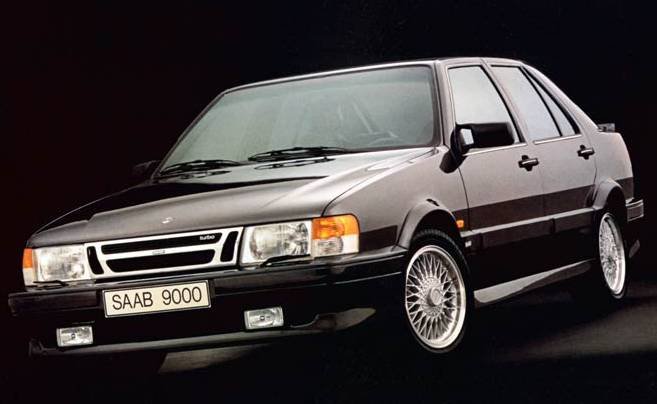 |
|
| Manufacturer | Saab Automobile |
|---|---|
| Production | 1984–1998 (503,087 produced) |
| Assembly | Sweden: Trollhättan Finland: Uusikaupunki (1984–1991) |
| Successor | Saab 9-5 |
| Class | Executive car |
| Body style | 4-door sedan (CD) 5-door liftback (CC, CS) |
| Layout | Front-engine, front-wheel drive |
| Platform | Type Four |
| Engine | 2.0 L I4 (petrol) 2.0 L I4 (t/c petrol) 2.3 L I4 (petrol) 2.3 L I4 (t/c petrol) 3.0 L V6 (petrol) |
| Transmission | 4-speed automatic 5-speed manual |
| Wheelbase | 2,672 mm (105.2 in) |
| Length | CC: 4,620 mm (181.9 in) CD 4,782 mm (188.3 in) CS: 4,665 mm (183.7 in) |
| Width | 1,763 mm (69.4 in) |
| Height | 1,420 mm (55.9 in) |
| Curb weight | 1,410–1,475 kg (3,100–3,250 lb) |
| Designer(s) | Björn Envall Giorgetto Giugiaro |
The Saab 9000 is a large executive car that was produced by the Swedish company Saab from 1984 to 1997. Representing the company's foray into the executive car scene, the 9000 remained in production until it was replaced by the 9-5 in late 1997.
Saab designed the 9000 as part of the Type Four platform in conjunction with the Italian automaker Fiat.
While the Lancia presented in autumn 1984 and the Fiat presented in mid-1985 looked very similar to the Saab, the Alfa Romeo introduced in autumn 1987 had only a few visible body parts in common with these models. Some parts among the four vehicle types were interchangeable. For example, the doors of the Fiat Croma also fit into the Saab 9000, but the door strips are different and fastened differently.
The side impact protection , which was standard on Saab models from 1986 onwards , was also missing from the Fiat doors , as Fiat took a different approach to occupant safety for the Fiat Croma and the Lancia Thema. Fiat designed a more stable passenger cell for its models (in particular the second series of the Thema, which was available from autumn 1988 and the Croma, which was revised at the beginning of 1991), while the Saab 9000 continued to use the original, jointly designed body with struts and improvements (such as the side impact protection struts in the doors ) was reinforced.
Various chassis parts (dome bearings, suspension struts, etc.) are interchangeable, and the windshield of the Croma, Thema and the Alfa 164 are the same as that of the Saab 9000. The drag coefficient (c w ) is 0.32. The mold was of Giorgetto Giugiaro designed .
On the 9000, the ignition lock is in the dashboard next to the steering wheel and not on the gear lever as on the Saab 99 , 90 or 900 . The chassis consisted of MacPherson struts at the front with anti-roll bar and a rigid axle at the rear with coil springs , anti-roll bar, trailing arms and Panhard rod . The standard tire size was 195/60 VR 15.
tomobiles. Fiat retailed similar derivative versions as the more basic Fiat Croma, the luxury-themed Lancia Thema, and the sports-oriented Alfa Romeo 164. Unlike the 164, which shares only the chassis, the Croma and Thema are outwardly similar to the 9000. As such, much of the bodywork appeared interchangeable between the 9000, Croma and Thema; for example, the doors. However, because Saab fitted heavier side impact protection they will not fit.Only seven different parts are actually interchangeable.The 9000's body was designed by Giorgetto Giugiaro and Saab designer Björn Envall.
Despite being shorter overall than the 900, the 9000 had a longer wheelbase and greater interior space, and was the first vehicle imported to the United States to be classed as a "large car" by the EPA.
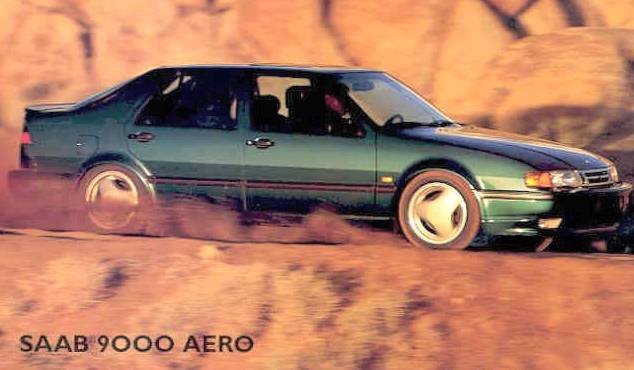
History
The 9000 was launched in 1984 as a five-door liftback only sharing much of its appearance and bodywork with the Type Four platform relatives—the Fiat Croma and Lancia Thema. Later in 1988, Saab released a sedan variant of the 9000 known as the "CD". This was followed by the 1991 release of a partially redesigned five-door liftback, known as the "CS". At the release of the "CS", the original liftback variant was retrospectively designated "CC" to differentiate it from the newer version, which it continued to sell alongside in some markets as an entry-level model.
With the introduction of the "CD" in 1988, Saab took the opportunity to re-style the front-end for the sedan. This involved smoothing the edges of the headlamps and grille, and sloping the front outwards, marking a departure from the more upright front styling of the 1984 original. From late 1990, the "CC" liftback received this same front-end facelift. A second facelift arrived in 1991 with the launch of the "CS" liftback. Fitted with a much narrower front profile, this facelift made its way to the "CD" sedan in 1994, albeit, with clear as opposed to the amber front turn signals fitted to the "CS". The "CS" was in turn facelifted in circa 1995 gaining these clear lenses that had earlier debuted on the sedan (CD). Therefore, while each body variant received one facelift, they were all applied at different times.
Unlike the 900, the 9000 kept the ignition switch in the more conventional steering column position rather than between the front seats. The inspiration for the seats was taken by Björn Envall from The Muppet Show's Pigs in Space,a sketch by the late puppeteer Jim Henson.
Saab Direct Ignition was fitted to the 9000 CD in 1988 on some models and expanded to all turbocharged 9000s in 1990. As early as 1989, the 9000 was equipped with the larger B234 2.3-litre engine, providing 150 hp (110 kW) in the normally aspirated engine. From late 1990, the B234 became available with a turbocharger, producing 147 kW (200 PS).
In 1993, the "Aero" was introduced, and was the most powerful Saab to date upon its introduction. The "Aero" was powered by a 168 kW (225 hp) version of Saab's 2.3-litre B234 engine, with more power courtesy of a larger Mitsubishi TD04 turbocharger. Automatic transmission-equipped "Aeros" were limited to 149 kW (200 hp) and kept the regular turbocharged models' Garrett AiResearch T25 turbocharger. Aeros were equipped with paint-matched body kit and spoiler, eight-way Recaro-designed heated sports seats, a sport suspension, and 16-inch Super Aero wheels. The Aero's in-gear acceleration was strongly emphasised; the Aero was capable of accelerating from 80 to 121 km/h (50 to 75 mph) faster than a Porsche Carrera 4 or a Ferrari Testarossa. The Aero was discontinued after 1997.
An optional trip computer, the SCC, was introduced for the 1993 model year, and provided mileage, speed warning, and alarm functions.A new turbocharger management system, Trionic 5, was equipped from the 1993 model year onwards. The Trionic system used resistor spark plugs to detect for engine knock in place of the knock sensors incorporated into the engine block in the previous APC system.
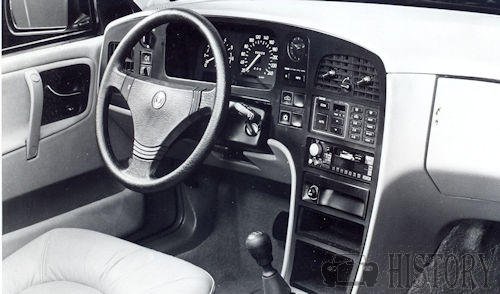
From 1988, all 9000 variants were equipped with a Saab Information Display (SID) which showed fuel consumption, distance to an empty fuel tank, alternator output voltage, outside temperature, and lowest battery voltage during vehicle start.If the outside temperature fell to -3 to 3 °C (27 to 37 °F), the temperature display is automatically selected to warn of possible "black ice" road conditions. A separate pictogram monitored door and hatch opening and exterior light bulb condition.
In the United Kingdom, a limited run of 9000 "Carlsson" models were produced, with a paint-matched airflow body kit, spoiler, and specially tuned turbocharged engine producing 160 kW (220 hp) with a manual transmission or 150 kW (200 hp) with the automatic. A number of the Carlsson editions fitted with the B202 turbocharged engine were sold into the Australian market.
A limited edition "Anniversary" model was introduced to mark Saab's 50th anniversary, featuring leather seats embossed with the classic, aircraft-inspired Saab logo and a colour-keyed body kit.
Only 1,400 9000s were produced for the 1998 model year, and of these only 400 were exported to the United States. In total, 503,087 Saab 9000s were manufactured.
| Fuel Capacity | 66 litres |
|---|---|
| Weight | 1360kg |
| Length | 4761mm |
| Width | 1778mm |
| Height | 1420mm |
| Wheelbase | 2672mm |
| Turning Circle | 10m |
9000 CC (liftback)
Originally known simply as the "9000", the original liftback variant was later given the "CC" identifier, standing for "combi coupe", to differentiate it from the CD sedan and CS liftback. While originally equipped with an upright front design, this was replaced by the sloped version in mid-1990—the design that had earlier debuted on the 9000 CD (sedan) in 1988.
The original 1984 model was powered by a water-cooled, turbocharged, double overhead camshaft, 16-valve inline-four engine, providing 130 kW (175 hp).Earlier on in the development, the PRV engine had also been considered. Both a five-speed manual and four-speed automatic transmissions were available. Later in 1984, a normally aspirated engine was introduced in the 9000 and 9000 S models, producing 97 kW (130 hp).
9000 CD (sedan)
At the Birmingham Motor Show in September 1988, Saab premiered the four-door sedan body style with a slightly more aerodynamic nose. Known as the "CD", this was originally available only with the turbocharged engine. In late 1989, the CD range in most of the world was expanded downward with the naturally aspirated 2.0-litre inline-four. This change did not happen until late in the 1990 model year for the US market, when Saab introduced the 150 hp (112 kW) 2.3-litre B234 normally aspirated engine.
The limited edition 9000 "CD Griffin" was available in 1991 for the 1992 model year in the United States and was highly appointed with luxury features including all available electric options, special eucalyptus green paint, a separate rear-seat air conditioning system, walnut trim and rear window blinds.
When Saab released the redesigned liftback model, designated CS in 1991, it debuted a slimmer front-end design characterised by a much smaller (thinner) grille and headlamps. As part of a 1994 facelift, Saab grafted this slimmer frontal styling to the CD as well. At the same time, the tail-lamps were refreshed, with extensions to either side of the license plate alcove and white turn signal lenses replacing the previous model's amber rear turn signals.
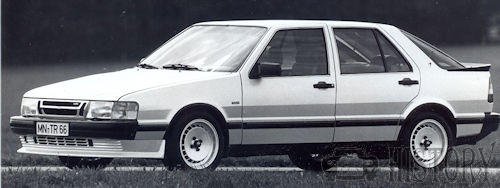
9000 CS (liftback)
Saab presented an updated version of the liftback body variant in 1991 for the 1992 model year with the "CS". Featuring a lowered front fascia with new headlights, grille and a substantially redesigned rear-end. Both the "CS" and better-equipped "CSE" editions were available with a 2.3-litre inline-four—either turbocharged or in normally aspirated tune. The "CS Turbo" was equipped with a low-pressure turbocharger setup producing 127 kW (170 hp), while the "CSE Turbo" sported a full-pressure turbocharger with 149 kW (200 hp). Both systems used the same Garett T25 turbocharger with a base boost pressure of .4 bar (6 psi) but the full pressure turbo is equipped with a boost control valve that is manipulated by the ECU. This allows the boost pressure to be increased as the ECU sees fit. Maximum stock boost on a full pressure turbo varies from .7 to 1.02 bar (10 to 15 psi) depending on the year and transmission.
2.3 CSE Turbo Performance
Performance 2.3 Turbo S
Power 203 PS (149 kW) at 5000 rpm
torque 244 1b ft (337 Nm) at 2000 rpm
Top gear speed at 1000 rpm: 21.6 mph (34.8 km/h).
Maximum speed 140 mph (225 km/h)
0 to 60 mph (97 km/h) 7.5 sec
80 mph (130 km/h) 11.5 sec.
Fuel consumption at constant 75 mph (120 km/h): 31.4 mpg
| Power | 225 bhp |
|---|---|
| Top Speed | 149 mph |
| 0-60 mph | 6.7 secs |
| Torque | 342 Nm |
| CO2 Emissions | 227 g/km |
| Euro Emissions Standard | 2 |
| Miles Per Tank | 406 miles |
In European markets, a smaller 2.0-litre engine was offered in normally aspirated form 97 kW (130 hp), light-pressure turbo 112 kW (150 hp) or full-pressure turbo 130 kW (175 hp).The "CDE" model was offered initially with only the 149 kW (200 hp) turbocharged engine, and later the 3.0-litre V6.
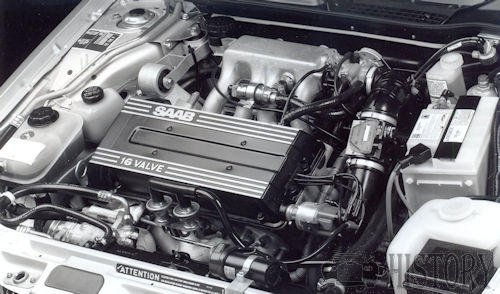
In 1995, a 3.0-litre B308 V6 engine with 157 kW (210 hp) was introduced as standard for the "CDE" sedan and optional for the "CSE" liftback. The V6 was discontinued in the United States after one year along with the "CDE" model, but continued on in Europe until 1997. In some European markets, a high-spec "CDE Griffin" model was offered with numerous luxury appointments. After the 1995 model year, naturally aspirated four-cylinder engines were discontinued in the United States.
For the 1998 model year, all manual transmission equipped 9000 CSEs received the 168 kW (225 hp) Aero engine, along with special 16-inch Super Aero wheels detailed with exposed lug nuts.
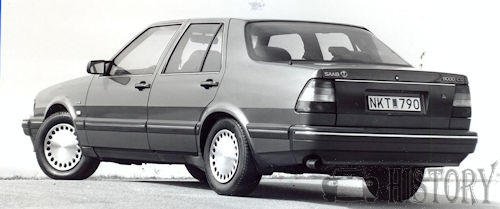
Technical
-
Saab 9000 Technical details and specifications (1984-1998)
BODY AND CHASSIS
Type of construction - Integral
Material of body panels - Steel; aluminium rear window frameDIMENSIONS
Length overall - 4620mm. (15ft. l.9in.)
Width overall - 1764mm. (69.45in.)
Height overall (unladen) - 1430mm. (56.3in.)
Weight (kerb) - 1370/1410 kg. (26-97/27-75cwt.)
Ground clearance - 150mm. (5•9in.)
Track - Front 1522mm.(59•9in. Rear - 1492mm. 58•7in.
Wheelbase - 2672mm. 105•2in.)
Turning circle diameter - 11.9m. (35ft. 9in.)Fuel tank: 14.5 Imp. gall (66 litres).
FRONT SUSPENSION
Type Coil spring/struts; gas shock-absorbers; anti-roll bar
REAR SUSPENSION -
Type - Solid axle; coil springs; two trailing and two leading llnks; Panhard rod; gas shock-absorbers; anti roll bar2.0 L I4 (t/c petrol) Type - (B202) 1985cm.3
ENGINE
Type - (B202) 1985cm.3
4-stroke; twin O.H,C.; 4valves per cyl.hydraulic tappets
Cooling system - Water pump, radiator bar , elcetric fan (on 0.9/1.2bar/85° 85°C.), thermostat (89°±2°C)
Number of cylinders - 4 (direct in block)
Firing order - 1-3-4-2
Idling speed - 850±75 r.p.m,
Bore - 90mm.
Stroke - 78mm
Cubic capacity - 1985cm.3
Compression ratio - 9.0:1
Brake horsepower (DIN) - 175 at 5300 r.p.m.
Torque (DIN) - 273 N.m. (2011b.ft.) at 3000 r.p.m.TRANSMISSION
Type - Front-wheel drive; integral engine/ gearbox
Clutch - Fichtel & Sachs, 228mm., hydraulic op.
Gearbox (manual) - 5-speed
Gearbox ratios (manual) - 0.68; 0.86; 1.17; 1.76; 3.31; R., 3.21:1BRAKES (Split circuit)
Front - 280X22 (min., 20)mm. ventilated discs
Rear - 258X 9 (min.,7.5)mm.discs
Handbrake - Mechanical, on rear discsSTEERING
Type - Rack and pinion, power-assistedEngine:2.3 Turbo S
Front-mounted transverse four-cylinder with counter-rotating balance shafts
twin ohc, 16 valves, and Garrett T 25 turbocharger intercooler
Bore 90.0 mm, stroke 90 mm
capacity 2290 cc
Compression 8.5-to-l.
Catalyst: standard.Transmission:
Front-wheel drive
five-speed manual gearbox.
Auto- matic, optional extra, four-speed.Suspension:
Front, independent, MacPherson struts, anti-roll bar.
Rear, dead beam axle on trailing arms with Panhard rod ; coil springs.Steering:
Rack and pinion
Power assistance: standard.Brakes:
Vented discs front, solid discs rear
ABS: standard.Tyres: 205/60 VR 15.
© Motor car History
Saab 9000 Model history
- 09.1984: After five years the development was completed.
- 04.1985: Market launch of the five-door 9000 with hatchback (CC) with turbo engine (129 kW, 175 PS without catalytic converter); in the USA it was only presented in 1986.
- 01.1986: The 2.0i engine with 94 kW (128 hp) without a catalytic converter follows
- 09.1987: Water cooling for the turbocharger
- 09.1988: The 9000 CD notchback sedan with a sloping front section and direct ignition (red ignition cassette on the turbo) comes onto the market.
- 09.1989: New in the range: 2.3 l engine without turbo with 107 kW (146 PS). It is equipped with two counter-rotating balance shafts to reduce vibrations.
- 09.1990: the 2.3-liter engine with turbocharger and 143 kW (195 hp) joins the range, also equipped with balancer shafts. He had an ion current measurement for knock control. The CC now has the bevelled front of the CD.
- 08.1991: Start of sales for the 9000 CS with lower headlights and modified rear end. The production of the CC is discontinued.
- 02.1993: Introduction of the first 32-bit motor control for cars, the Saab Trionic version T5.2, the following models run under T5.5. In addition, the delivery of the 9000 CS Aero, the most powerful and fastest Saab at the time, with an improved version of the 2.3-liter turbo that developed 162 kW (220 hp) - the version with automatic transmission was open because of the high torque 147 kW (200 PS) reduced - special 16 "'Super Aero' wheels and lowering to improve driving characteristics.
- 09.1993: Start of the Ecopower engine, a light pressure turbo with 125 kW (170 PS); Performance increase of the 2.3-liter turbo to 147 kW (200 PS), with the Aero it is 165 kW (224 PS); all 9000 models have two full-size airbags as standard
- 07.1994: New in the engine range: a 3.0 l V6 engine from General Motors without turbocharger with 155 kW (211 PS) and the 2.0 l light pressure turbo engine as Ecopower with 110 kW (150 PS). The Ecopower had an electric heater for the catalytic converter , which reduced the pollutant emissions shortly after the engine was started. The 9000 CD is being revised and has the front of the CS and a modified rear.
- 12.1997: The aero model is no longer in production; all 2.3-liter turbo models have an output of 224 hp.
- 05.1998: Production is ended after a total of 503,087 copies produced. Its successor was the Saab 9-5 , which was introduced in autumn 1997 .
Service
-
Saab 9000 Service Guide (1984-1998)
2.0 L I4 (t/c petrol) Type - (B202) 1985cm.3
ELECTRICAL SYSTEM
Ignition timing - 16° BTDC at 850 r.p.m., vac. hose off
Sparking plugs - Bosch F6DC; Champ. C7GY or C7YC
Sparking plug gap - 0•6mm. ( •024in.)
Distributor - Bosch 0237 507 001
Battery - 12 V. 60A.h., negative earth
Alternator - Bosch Kl-14V70A20 or NI-14V80A19
Starter motor - Bosch DW12V, 1-4kW.CAPACITIES
Engine oil - 4.0 litres (7.0 pints) with filter
Transmission - 2.5 litres (4.4 pints)
Cooling system - 10 litres (17.6 pints)
Fuel tank - 68 litres (15 gallons) approx.
Tyre size - 195/60VR15; spare (G.B.) Tl 15/70R15
Tyre pressures - front 1-9 (27) rear 1-9 (27)
Hydraulic fluid type - DOT4 specification
Maximum towing weight - 1600kg. (31.49cwt.)Advanced Maintenance
ENGINE Type - (B202) 1985cm.3
4-stroke; twin O.H,C.; 4valves per cyl.hydraulic tappets
Cooling system - Water pump, radiator bar , elcetric fan (on 0.9/1.2bar/85° 85°C.), thermostat (89°±2°C)
Number of cylinders - 4 (direct in block)
Firing order - 1-3-4-2
Idling speed - 850±75 r.p.m,
Bore - 90mm.
Stroke - 78mm
Cubic capacity - 1985cm.3
Compression ratio - 9.0:1
Brake horsepower (DIN) - 175 at 5300 r.p.m.
Torque (DIN) - 273 N.m. (2011b.ft.) at 3000 r.p.m.
Piston diameter (standard) - 89.986/89.870 in 4 grades; 16mm. above skirt bottom
Piston clearance in bore - 0.02/0.05mm
Piston rings—width - (1) 1.73/1,75mm.; (2) 1.98/1.99mm.(3) 2-63/ 2-73
Piston rings—gap (in bore) - (l) 0.35/0.55(2) 0.30/0.45; (3) 0.38/ 1.40
Oil pressure. - 3.0bar (43 1b./in.2) min. at 2000 r.p.m.
Gudgeon pin diameter - 23•996/24mm
Gudgeon pin fit in piston - Sliding fit under light thumb-pressure
Gudgeon pin fit in con. rod - 0.005/0.014mm. clearance
Crankpin diameter - 51.981/52mm.
Crankpin undersizes - 025, 0.50, 0.75, 1.00mm.
Big-end bearing clearance - O.026/O.062mm.
Main journal diameter - 57.981/58mm.
Main journal undersizes - 0.25, 0.50, 0.75, 1.OOmm.
Main bearings - 5
Main bearing clearance - 0.020/0.62mm.
Crankshaft end-float - 0-08/0•062mm.
Crankshaft end-thrust on - Centre bearing thrust washers
Camshaft journal diameter - 28.922/28.935mm.
Camshaft bearings - 5 per shaft
Camshaft end-float - 0-08/0•035mm.
Camshaft drive type - Duplex chain
Cam lift (0 clearance) - 1 8.65 and 6.65mm.; E. , 8.65
Valve head diameter - 1.6.965/6.975 , E., 6.955/6.980
Valve seat angle - 45° (face angle, 45° 30')
Valve guide length - 49•0mm.
Valve stem/guide clearance . - Max. rock, 0•5mm. at head raised 3mm. above seat
Valve spring free length - 45•0mm.
Valve spring loaded length - 28-4mm. under 595/645N (134/1451b.)
Valve working clearance - Hydraulic tappets
Valve timing clearance - 1., 0.35mm. (.014in.); E., 0.55 (.022)
Valve timing (clearance as 47) - 10°BT-56°AB-56 BB°-16°AT
Petrol pumps - 2 electric. 900cm.3/30sec. min. at 2.5 bar
back pressure
Injection system - Bosch LH-Jetronic
Exhaust gas analysis - co, 0.9/1.60%
Turbocharger - Garrett AiResearch T3
Boost pressure - Basic 0.40+0.3, bar; 0.95+0.05max.TRANSMISSION
Type - Front-wheel drive; integral engine/ gearbox
Clutch - Fichtel & Sachs, 228mm., hydraulic op.
Gearbox (manual) - 5-speed
Gearbox ratios (manual) - 0.68; 0.86; 1.17; 1.76; 3.31; R., 3.21:1
Drive shafts - With inner/outer C.V. joints
Final drive gear - Spur gears
Final drive ratio - 4.21:1 (80/19)
BRAKES (Split circuit)
Front - 280X22 (min., 20)mm. ventilated discs
Rear - 258X 9 (min.,7.5)mm.discs
Handbrake - Mechanical, on rear discs
Linings—front - 11 (min., 1 mm. pad thickness
Linings—rear - 11 (min., 1 mm. pad thickness
Power assistance - Girling 8in. vac. servo (4: l)STEERING
Type - Rack and pinion, power-assisted
Condition for checking - Unladen
Camber angle 0° 39'±30'
Castor angle 1° 39'±30'
King-pin Inclination - 11° 18'±30'
Wheel alignment (front) - Toe-in 2±1mm. at rim
Toe-out on turns - Inner, 21°±30' with outer at 20°FRONT SUSPENSION
Type Coil spring/struts; gas shock-absorbers; anti-roll bar
Number of coils - 5'5 active
Wire diameter (mm,) - (a) 12.86; (b) 12.97; (c) 13.09
Spring length—free - 455mm
Colour code' - (a) Violet; (b) Orange/ Pink; (c) Black/White
REAR SUSPENSION -
Type - Solid axle; coil springs; two trailing and
two leading llnks; Panhard rod; gas shock-absorbers; anti roll bar
Wheel camber - -0° 15'+15'
Wheel alignment (rear) - Toe-in 2° 30'±1° 30'
Number of coils (turns) - 8 active
Wire diameter (mm) - 13.4 (Brown/Blue); 13.6 (Black/White)
Spring length—free - 321 mm.ELECTRICAL SYSTEM
Ignition timing - 16° BTDC at 850 r.p.m., vac. hose off
Sparking plugs - Bosch F6DC; Champ. C7GY or C7YC
Sparking plug gap - 0•6mm. ( •024in.)
Distributor - Bosch 0237 507 001
Rotor arm resistance - 1000 ohms
Vacuum advance starts - 1/2°/+ 1/2° at 60mm.Hg.
Vacuum advance—max. - 4°/6° at 225mm.Hg.
Pressure retard - 2°/4° at 225mm.Hg.
Ignition coil - Prim. res., 0-52/0-76 ohms
Battery - 12 V. 60A.h., negative earth
Alternator - Bosch Kl-14V70A20 or NI-14V80A19
Starter motor - Bosch DW12V, 1-4kW.CAPACITIES
Engine oil - 4.0 litres (7.0 pints) with filter
Transmission - 2.5 litres (4.4 pints)
Cooling system - 10 litres (17.6 pints)
Fuel tank - 68 litres (15 gallons) approx.
Tyre size - 195/60VR15; spare (G.B.) Tl 15/70R15
Tyre pressures - front 1-9 (27) rear 1-9 (27)
Hydraulic fluid type - DOT4 specification
Maximum towing weight - 1600kg. (31.49cwt.)TORQUE SPANNER lb.ft.
Cyl, head bolts - (l) 43; (2) 65*• (4) 65; (5) +96°
Big-end bearing nuts - 40
Main bearing bolts - 80
Camshaft bearing cap bolts - 11
Flywheel bolts - 43
Crown wheel bolts - 51/65
Road wheel bolts - 65/80
Hub nuts (F. & R.) - 195/210
Steering wheel nut - 20© Motor car History
-Saab 9000 Advanced Maintenance is available for registered users-
© Motor car History
